Hearing Loss Statistics: Hearing loss refers to the partial or complete inability to hear sound at one or both ages. There are several causes of hearing loss such as genetics, age, exposure to loud noise, certain medications, infections, and physical trauma to the ear.
According to the World Health Organization (WHO), deafness and hearing loss are widespread and found in every region and country. Nearly 20% of the global population (more than 1.5 billion people) live with hearing loss and 430 million of them have disabling hearing loss.
It is projected that there could be over 700 million people with disabling hearing loss by 2050.
There are three main types of hearing loss: Conductive hearing loss, mixed hearing loss, and sensorineural hearing loss.
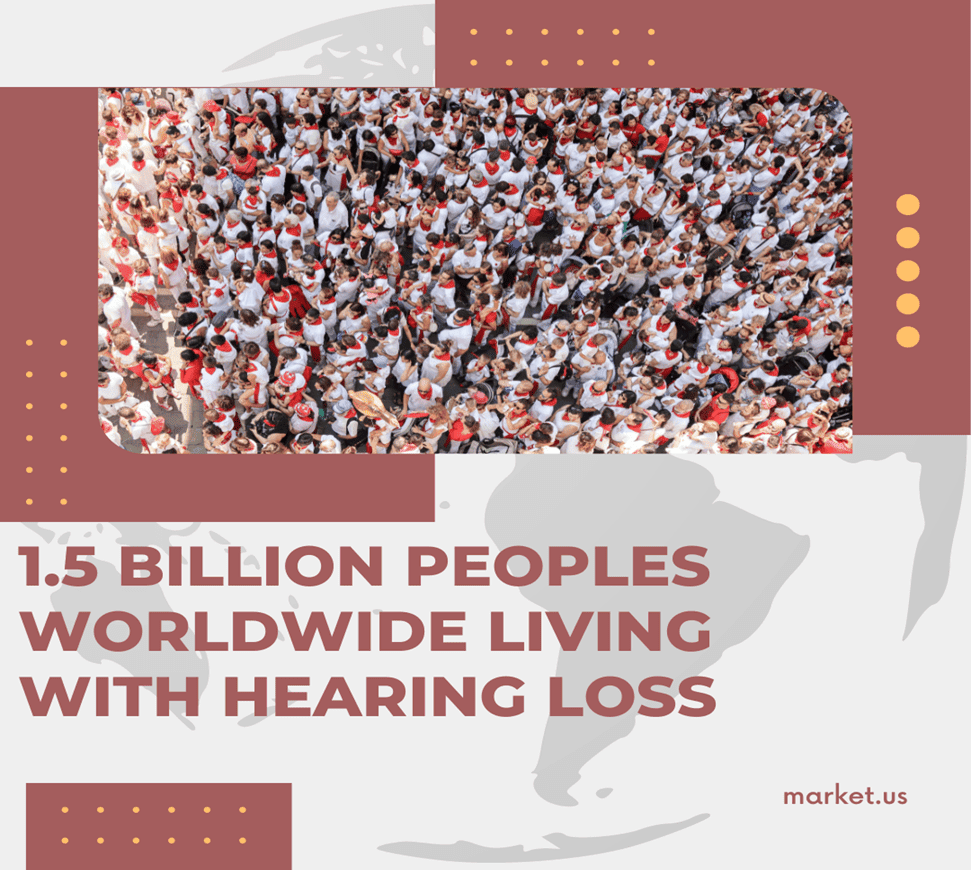
Table of Contents
Hearing Loss Statistics – Worldwide
- Globally, about 34 million children have deafness or hearing loss.
- Out of all hearing loss cases, 60% of cases are preventable.
- Approximately, 30% of people over 60 years of age have hearing loss.
- The burden of hearing loss is more in low- and middle-income countries.
- WHO estimates that global hearing aid protection covers just 3% of the need in these countries.
- According to the World Health Organization (WHO), 50% of hearing loss can be prevented through public health measures.
- Nearly 2.5 billion people are expected to have some degree of hearing loss and at least 700 million people will require hearing rehabilitation by 2050.
- More than 1 billion young adults have a permanent risk of hearing loss due to unsafe listening activities.
- About 80% of people with hearing loss are currently living in low- and middle-income countries.
- More than 25% of people are affected by disabling hearing loss.
- In children, more than 60% of hearing loss is due to avoidable causes.
More Insights
- 1 in 4 people is projected to have hearing loss problems by 2050.
- About 50% of individuals aged 12-35 years have a high risk of hearing loss due to prolonged and excessive exposure to loud sounds.
- About 90% of deaf children are born to hearing parents.
- Men are almost twice as likely as women to have hearing loss among adults aged 20-69 years.
- The prevalence of hearing loss is higher in non-Hispanic white adults.
- Non-Hispanic black adults have a low prevalence of hearing loss.
- About 2 to 3 out of every 1,000 children in the United States are born with a detectable level of hearing loss in one or both ears.
- An estimated 1 in 5 American teens experiences some degree of hearing loss.
- 12.5 percent of kids between the ages of 6 and 19 have hearing loss as a result of listening to loud music, particularly through earbuds at unsafe volumes.
- 2.7 million veterans receive either disability compensation for service-connected hearing disabilities or are in treatment for related hearing issues.
(Source: WHO, NIH, hearing loss)
Hearing Loss Statistics – by Age Group
- About 2% of adults aged 45-54 years have hearing loss problems.
- 8.5% of adults aged 55-64 years have hearing loss issues.
- 25% of adults aged 65-74 years have hearing loss issues.
- About 50% of adults aged 75 years and more have hearing loss issues.
(Source: NIH)
Hearing Loss Worldwide Statistics, by Age Group
Take advantage of our unbeatable offer - buy now!

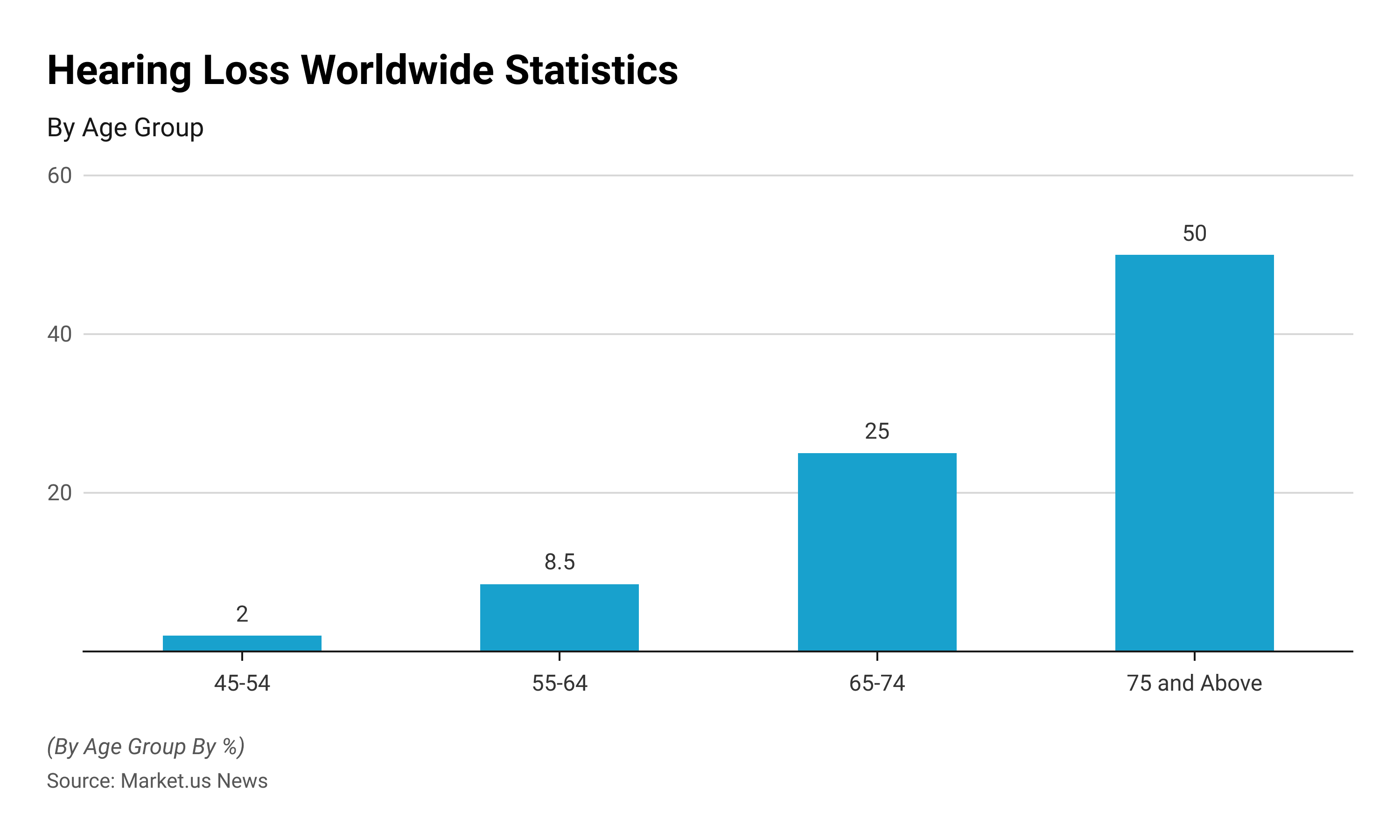
(Source: NIH)
Projected Number of People with Disabling Hearing Loss Worldwide in 2030, 2040, and 2050 Statistics
- In 2019 about 430 million people suffered from disabling hearing loss.
- In 2030, it is expected to grow the number of people with hearing disabilities to 509 million, and 612 million in 2040.
- The number of people with hearing disabilities is expected to reach 711 million by 2050.
(Source: Statista)
Projected number of people with disabling hearing loss worldwide in 2019, 2030, 2040, and 2050 (in millions)
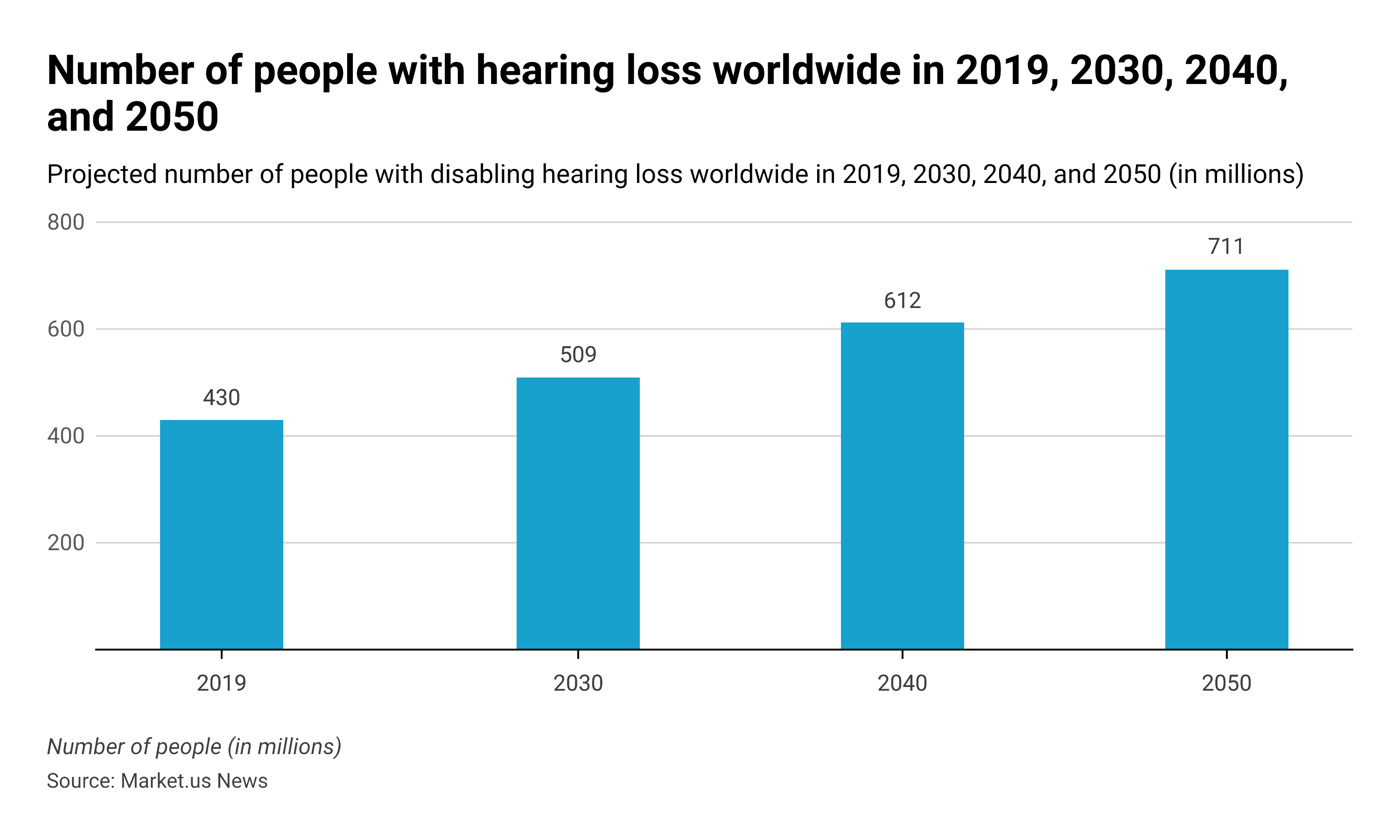
How Many People Are Deaf?
- About 2-4 of every 1,000 people aged 65 years and more in the United States are functionally deaf.
- More than 70 million people in the world are deaf and out of them, 80% of deaf people are living in developing countries.
- More than 1,700 babies in 2021 have been born deaf.
(Source: Forbes)
Global Hearing Aids Market, by Product Type
- According to market.us, the global hearing aids market accounted for a revenue of 7.7 billion in 2022.
- The global hearing aid market is expected to grow at a revenue of 13.2 billion by 2032, with a compound annual growth rate (CAGR 2022-2032) of 5.7%.
- The behind-the-ear (BTE), hearing aids segment had an over 40% revenue share in 2022.

Region Wise Hearing Loss Statistics
Hearing loss can affect people worldwide, regardless of their geographic location. However, there are certain regions of the world where hearing loss is more prevalent due to various factors such as environmental noise, genetics, and access to healthcare. According to the World Health Organization (WHO), the prevalence of hearing loss is higher in the Asia Pacific region, followed by sub-Saharan Africa, South Asia, and Latin America.
Prevalence of Hearing Loss in Asia Pacific Region Statistics
Asia Pacific is the most densely populated region and most likely the one with the highest number of people with hearing loss.
South East and Western Asia
- In 2021, about 401 million people have some degree of hearing loss in South-East Asia.
- It is expected that about 666 million people in South-East Asia will have some degree of hearing loss by 2050.
- More than 546 million people in the Western Pacific have some degree of hearing loss.
- About 21.5% of people in the Western Pacific region have a hearing disability.
- The value of hearing aids imported into South Korea in 2022 was USD 36.69 million.
- About 27.8 million people in China have disabling hearing loss.
(Source: hear-it, Statista, bmcpublichealth, biomedcentral)
India
- 1 in 4 people is projected to have hearing loss problems by 2050.
- Approximately 63 million people in India, are suffering from Significant Auditory Impairment.
- About 6.3% of the Indian population is suffering from hearing loss.
- The high prevalence of hearing loss is higher in adults aged more than 60 years in India.
- 67% of adults aged 40-59 years in India have hearing loss issues.
- The prevalence of hearing loss was 32.4% in the rural area of India and 26.1% in urban areas.
- About 30% of people have mild hearing loss issues, 13.7% of people have moderate hearing loss, and 51.2% of people in India have severe hearing loss issues.
(Source: indianexpress, main.mohfw, hear-it)
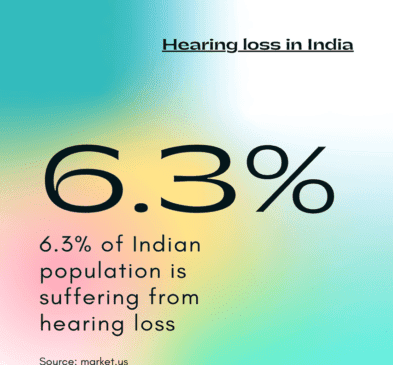
Australia
- About 3.6 million Australians have hearing loss and this number is expected to double by 2050. (Source: Hearing Australia – Annual Report 2021-2022)
- In 2021-2022 Hearing Australia helped more than 270,000 children and adults with hearing loss. (Source: Hearing Australia – Annual Report 2021-2022)
- In 2022, one in five children has a middle ear infection in Australia. (Source: Hearing Australia – Annual Report 2021-2022)
- 6% of children visited ear, nose, and throat (ENT) specialists in 2022 in Australia. (Source: Hearing Australia – Annual Report 2021-2022)
- In 2021-2022, Hearing Australia provided services to 29,908 young Australians under the age of 21 years. (Source: Hearing Australia – Annual Report 2021-2022)
- Hearing Australia provided services to 5,086 young adults between 21 and 26 years of age. (Source: Hearing Australia – Annual Report 2021-2022)
- In 2021-22 Hearing Australia provided services to 29,629 adults with complex hearing needs. (Source: Hearing Australia – Annual Report 2021-2022)
Prevalence of Hearing Loss in North America
Hearing loss is a prevalent health issue in North America, which is affecting millions of people in the United States and Canada. Age-related hearing loss is the most common type of hearing loss in North America.
According to market.us, the global hearing aids market was dominated by North America and accounted for the largest revenue of USD 2.6 billion in 2022.
(Source: market.us)

The United States
The prevalence of hearing loss issues is comparatively higher in the United States than in others.
- About 25.4 million people in the United States are suffering from mild hearing loss.
- Approximately 10.7 million people in the United States aged 12 years and older are suffering from moderate hearing loss.
- More than 1.8 million people aged 12 years and older are suffering from severe hearing loss issues.
- Approximately 15% of American adults aged 18 and over are suffering from hearing loss issues.
- About 2.10% of college students in the United States have deafness or hearing loss disability in 2022.
- 1 in 3 adults in the United States with hearing loss problems stated that they did not seek help because minor hearing difficulties are easy enough to live with untreated.
- 1 in 5 people with a disability stated that they do not get treatment because of high treatment costs.
- 60% of adults in the United States with hearing difficulties stated that they have difficulty hearing when there is noise in the background.
(Source: Forbes, NIH, Statista)
Share of The United States Adults Who Used Some Form of Hearing Aid as of 2021
- 6% of adults in the United States used hearing aids or another form of hearing assistive technologies in 2021.
- 3% of adults in the United States used other hearing assistive technologies to get aid with hearing loss problems.
- 2% of adults preferred cochlear implants to get aid with hearing problems.
- 90% of adults in the United States did not use any hearing aid in 2021.
(Source: Statista)
Percentage of adults in the United States who used hearing aids or other forms of hearing assistive technology as of 2021 (In %)
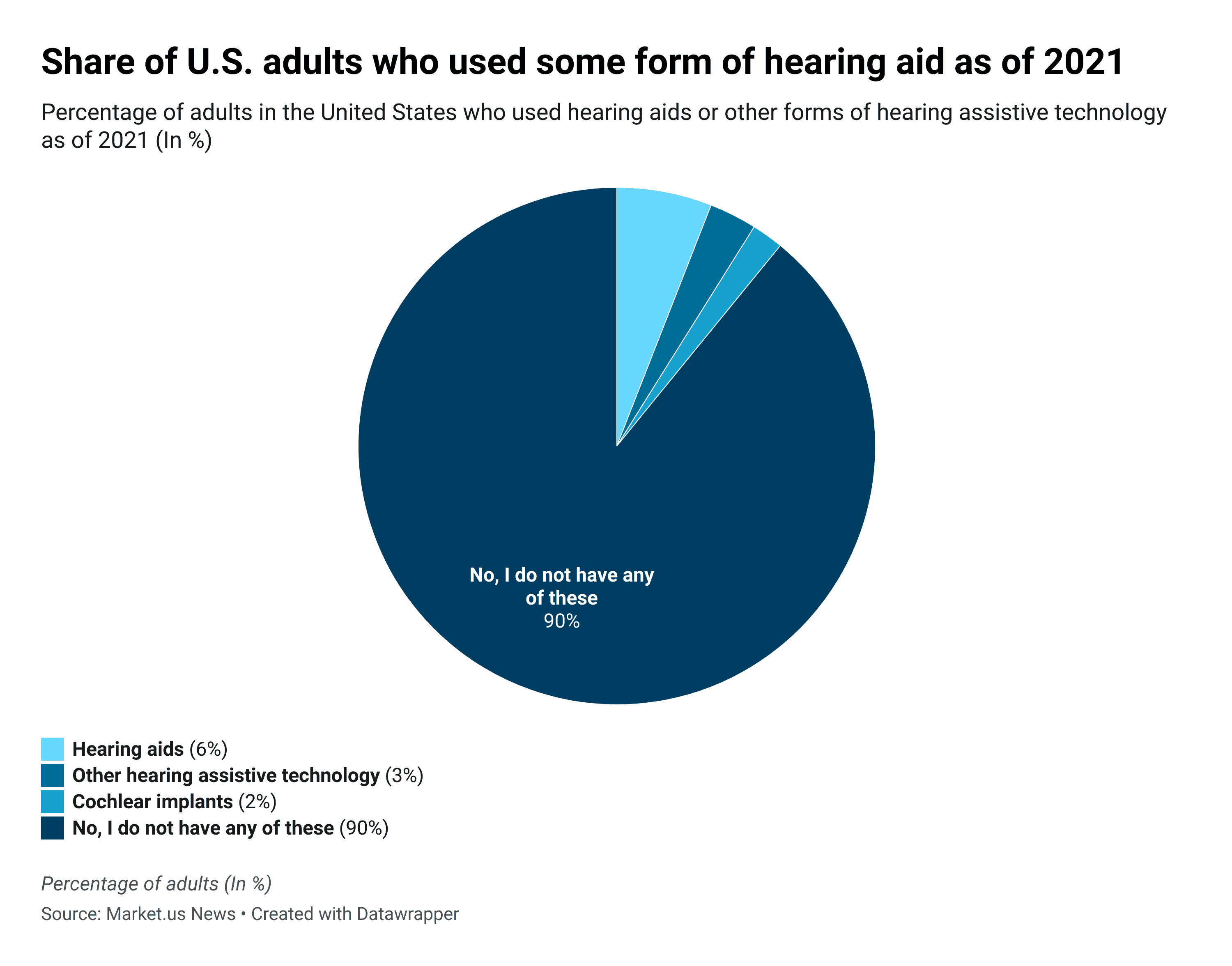
Hearing Problems Among Older Adults with Hearing Aids the United States, by Ethnicity
- 29.40% of non-Hispanic adults aged 65 years and above have some difficulty in hearing even when using a hearing aid vs 4% of non-Hispanic white adults with a lot of difficulties or cannot hear.
- 19% of non-Hispanic black adults aged 65 years and above have difficulty in hearing vs 1.90% of non-Hispanic black adults have a lot of difficulty in hearing even using hearing aids.
- 16.20% of non-Hispanic Asian adults have some difficulty in hearing vs 3.6% of adults have a lot of difficulty or cannon hearing even after using hearing aids.
(Source: Statista)
This statistic shows the percentage of adults aged 65 years and older with difficulty hearing even when using a hearing aid in the U.S. by ethnicity.
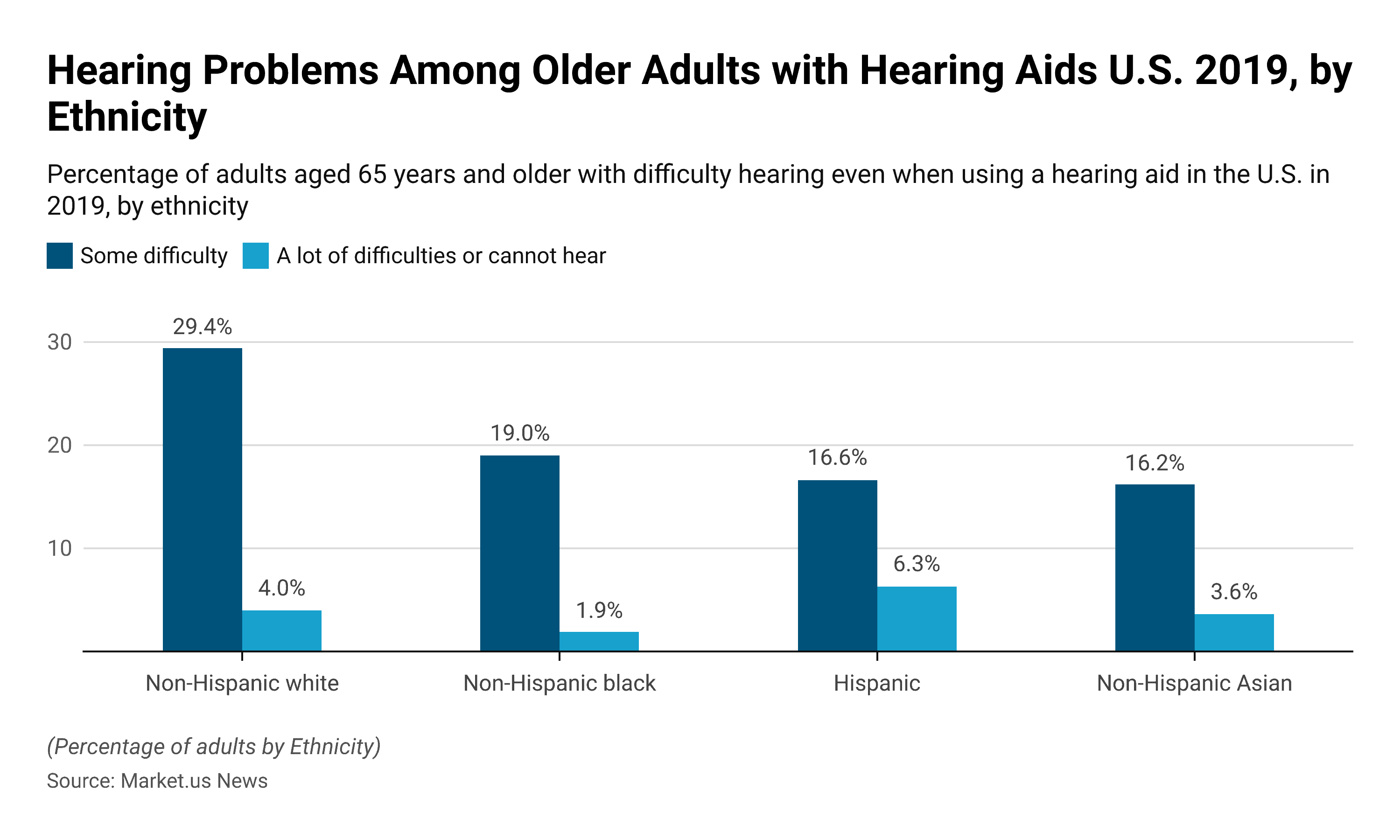
Hearing Difficulties with Hearing Aid Among Adults Over 45 Years U.S. by Gender
- Around 21.90% of men aged 45 to 64 years in the U.S. still experienced some difficulty hearing despite having a hearing aid. In comparison, 15.80% of women experienced this.
- 3% of men aged 45 to 64 years in the United States experienced some difficulty in hearing even after using hearing aids. In comparison, 2% of women experienced this.
(Source: Statista)
This statistic shows the percentage of adults aged 45 years and older with difficulty hearing even when using a hearing aid in the U.S. by gender.
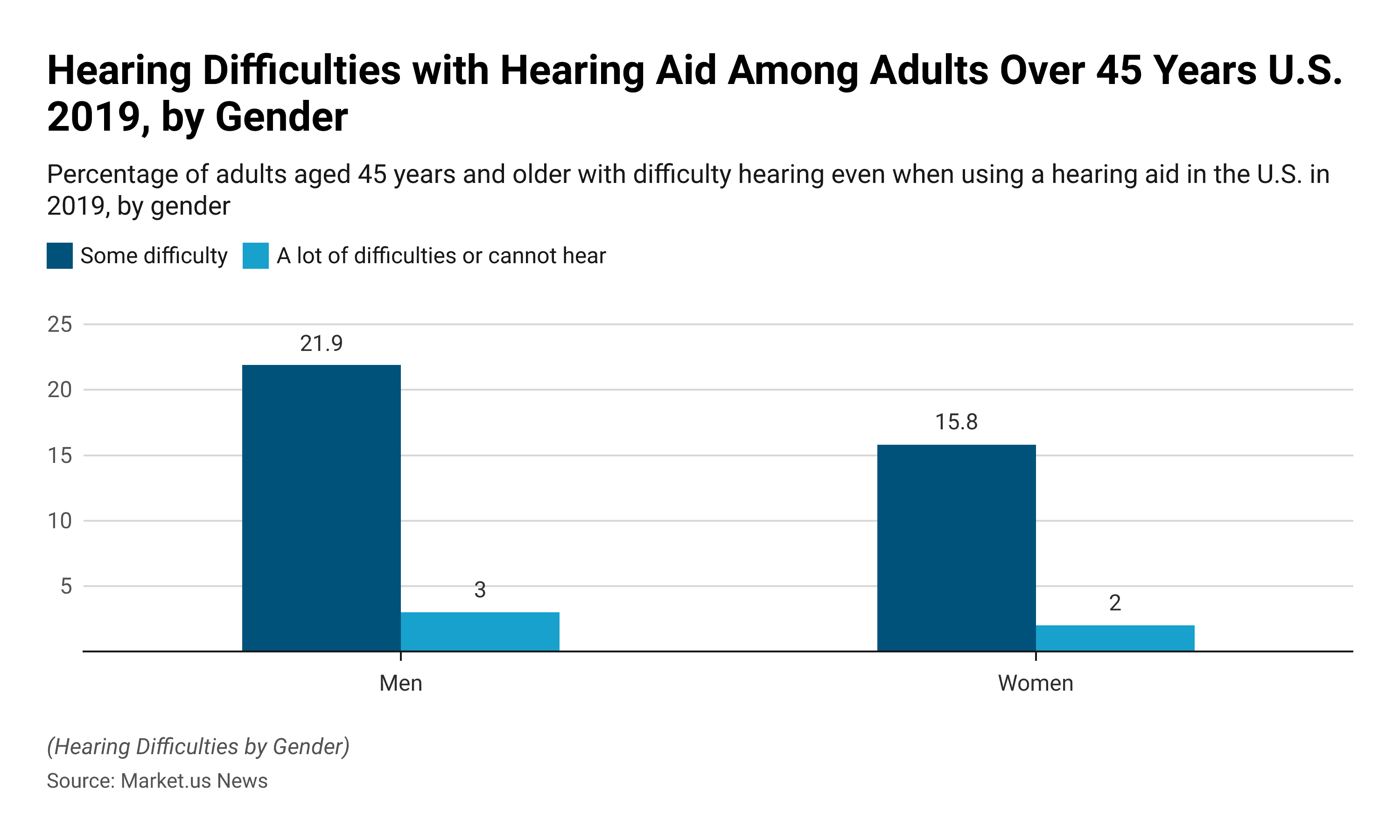
Canada
Hearing loss has significant concerns in Canada, with an estimated 10% of the Canadian population experiencing some degree of hearing loss.
- 3 in 5 adults in Canada have hearing loss issues.
- Hearing loss is common in Canadian men as compared to women.
- About 38% of adults aged 20 to 79 years have hearing loss, while 37% of adults have tinnitus.
(Source: statcan)
Audiometrically Measured Hearing Loss in Canadian Population, by Age Group
- 9% of adults aged 20-39 years have audio metrically measured hearing loss.
- 27% of adults aged 40-49 years have hearing loss, which is comparatively more common in adults aged 50-59 years (51%).
- 77% of adults aged 60-69 years have audio metrically measured hearing loss.
- The prevalence of hearing loss is higher in adults aged 70-79 years (94%).
(Source: Statistics Canada)
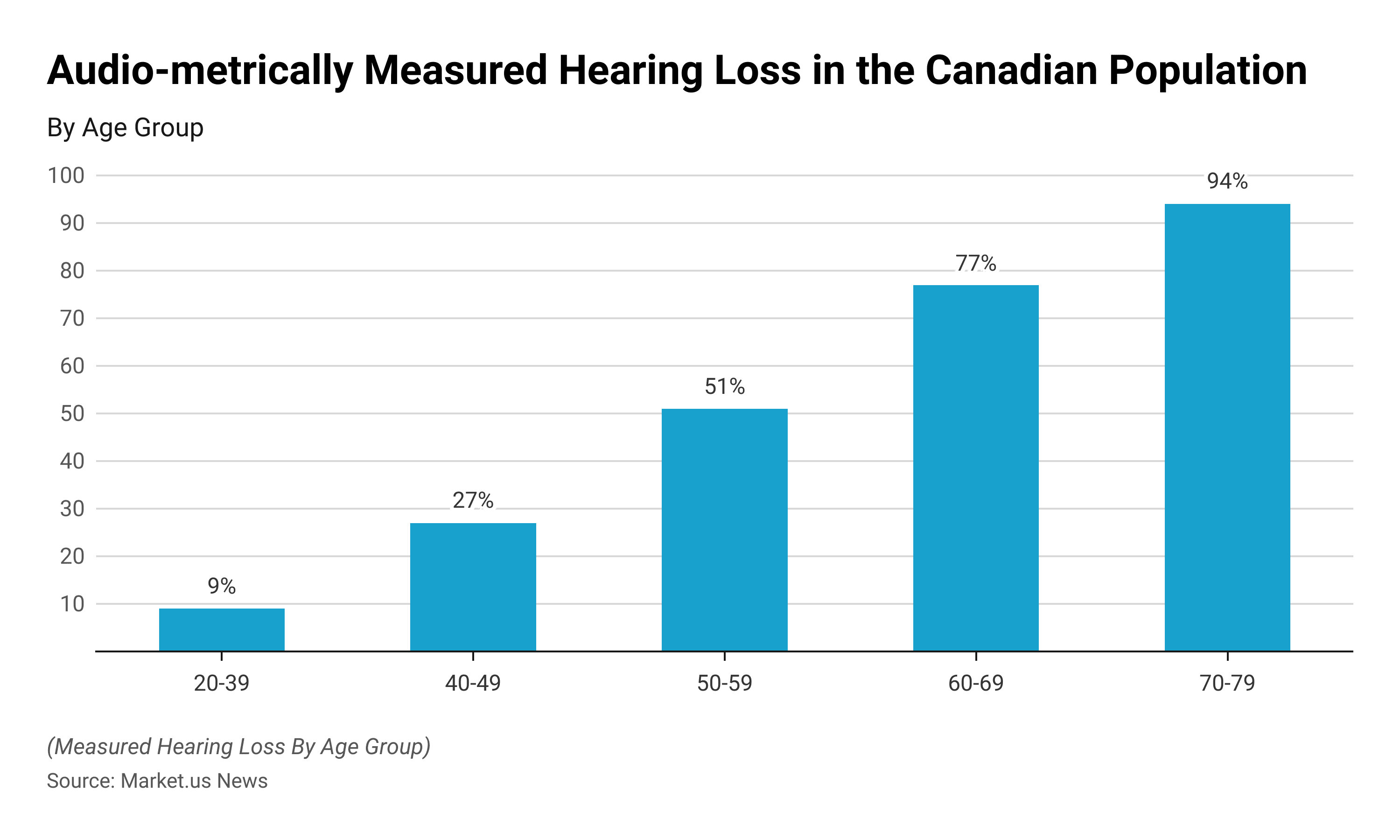
Prevalence of Hearing Loss in Europe Statistics
Hearing loss is a major concern in Europe, especially among older adults. According to the report of the European Commission, approximately 16% of the European population experiences some degree of hearing loss. Age-related hearing loss and noise-induced hearing loss are the most prevalent concerns in Europe.
- About 190 million people in the European region are living with some degree of hearing loss.
- It is expected that the number will grow to 230 million by 2050.
- Hearing loss can be expensive for communities, costing the region around USD 225 billion annually.
(Source: WHO)
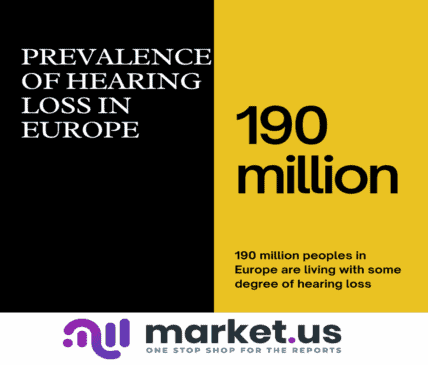
Prevalence of Hearing Loss in Latin America Region Statistics
Hearing loss is emerging as a critical issue in the Latin America region, with an estimated 40 million people affected by some degree of hearing loss. The common reasons behind hearing loss in Latin America are noise exposure, genetic factors, and lack of healthcare access.
- According to a report by the World Health Organization (WHO), 217 million people in Latin America are suffering from hearing loss.
- About 62.7 million people have a moderate or higher grade of hearing loss.
- It is expected that the number of people with hearing loss grow to 332 million by 2050.
- The prevalence of hearing loss is higher in Brazilian children is about 30%.
- More than 1.5 million Chileans are suffering from hearing loss disorders.
- In 2021, about 1000 children were born with hearing loss in Costa Rica.
(Source: WHO)
Hearing Aids Revenue in Latin America 2020-2025
- In 2022, the value of the hearing aids market in Latin America was USD 1.20 billion.
- The revenue is expected to grow to USD 1.28 billion in the 2nd quarter of the year 2023.
- The market for hearing aids in Latin America is expected to grow at a revenue of 1.25 billion by 2025.
- The market for hearing aids in Latin America is growing by a CAGR (2022-2025) of 7%.
(Source: Statista)
Hearing aids market value in Latin America from 2020 to 2025 (in billion U.S. dollars)
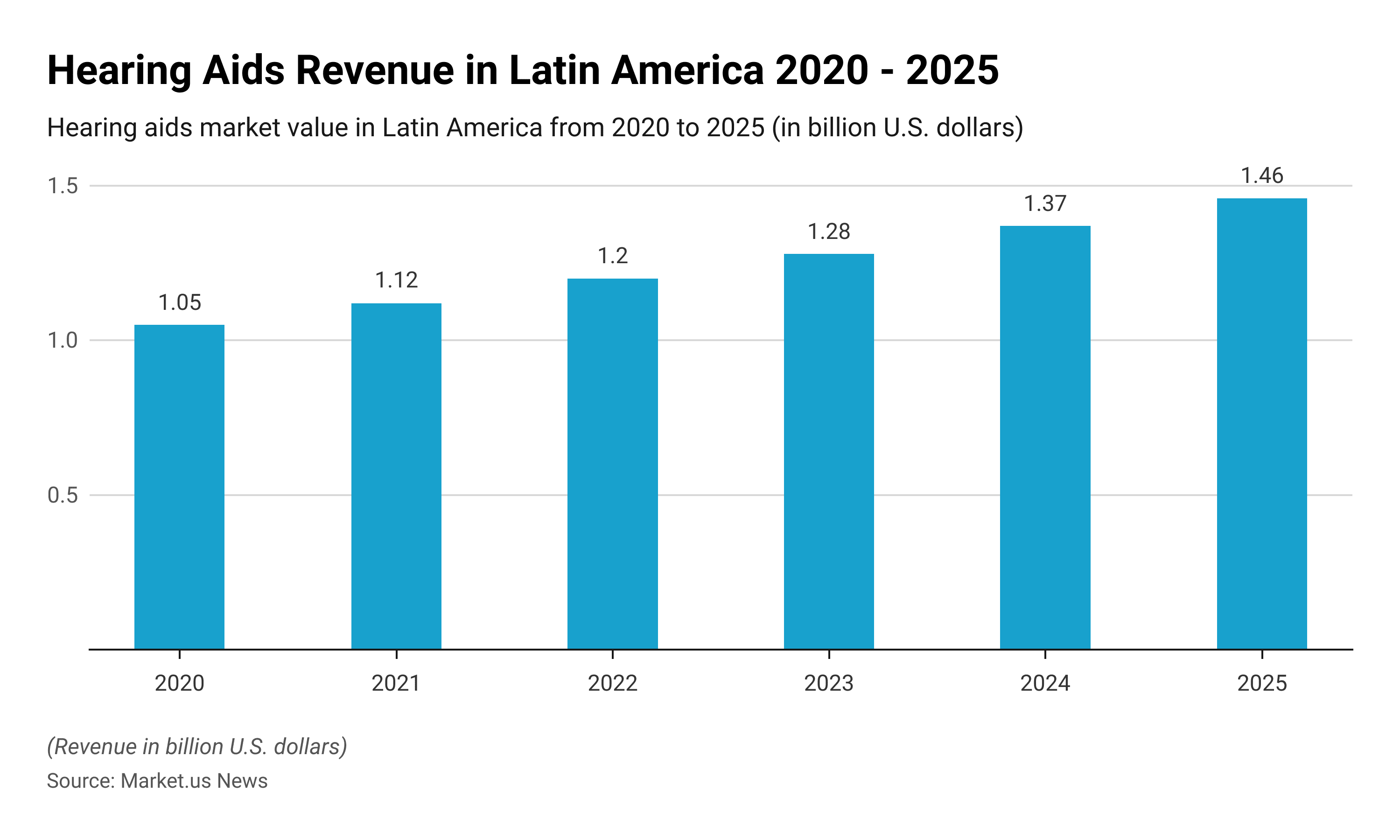
Prevalence of Hearing Loss in the Middle East & Africa Region
Hearing loss is a critical issue in the MEA, with a prevalence of around 7.2% of the population. According to the World Health Organization (WHO), the prevalence of hearing loss is increasing in MEA, with about 30 million people affected by hearing loss.
- The prevalence of hearing loss is higher in sub-Saharan Africa, as it occurs per 1000 live births as compared to a Lower incidence of 1 per 1000 live births in high-income countries.
- 30-50% of hearing loss in the Middle East & Africa region is due to genetic disorders
- 30% of hearing loss is due to hereditary.
- Non-syndromic hearing loss is occurring due to hereditary problems.
- The prevalence of hearing loss is estimated to be around 0.9% in Saudi Arabia.
- The prevalence of hearing impairment is about 7.5% in Saudi Arabia.
(Source: Springer Link, global audiology)
Recent Developments
Acquisitions and Mergers:
- HearingTech Inc. acquired SoundCare Solutions for $100 million, consolidating its position in the hearing aid market and expanding its product offerings.
- Audiology Innovations merged with HearWell Technologies, forming a comprehensive platform for hearing loss solutions, with combined annual revenues projected to surpass $300 million.
New Product Launches:
- HearClear introduced a new line of rechargeable hearing aids with advanced noise reduction technology, aiming to capture 20% of the hearing aid market share within the first year.
- AudioSense launched a smartphone-compatible hearing aid app for personalized sound adjustments and remote consultations, targeting 1 million downloads within six months.
Funding Rounds:
- HearBetter received $50 million in Series A funding led by Healthcare Investment Group XYZ to enhance their hearing aid technology and expand distribution channels, targeting a 40% increase in sales revenue over the next fiscal year.
- SoundSolutions secured $20 million in seed funding from Tech Investors ABC to support research and development efforts for innovative hearing loss treatments, anticipating a 30% growth in market share upon commercialization.
Consumer Trends:
- Rising awareness of hearing health and technological advancements in hearing aid devices fueled the demand for hearing loss solutions, with hearing aid sales increasing by 15% compared to the previous year.
- Bluetooth-enabled hearing aids witnessed a 20% growth in sales, reflecting consumer preference for connectivity and convenience in hearing aid technology.
Regulatory Landscape:
- Regulatory bodies implemented standards for hearing aid performance and safety, ensuring adherence to quality standards and consumer protection in the hearing healthcare market.
Wrap Up
Hearing loss is a widespread health issue that affects millions of people worldwide. Hearing loss prevalence is varying by region, and its concerns are increasing globally. These issues are increasingly emerging in the Asia Pacific and North American regions.
Men are more likely to have hearing loss issues as compared to women. Several health treatments are available for hearing loss, including hearing aids, cochlear implants, assistive listening devices, and medication/surgery in some cases.
It is important to raise awareness of hearing loss and promote access to hearing healthcare services to improve the quality of life for those who are affected by hearing loss. It is necessary to address comprehensive approaches that include prevention, early detection, and access to high-quality hearing healthcare services.
FAQs
According to market.us global hearing aids market accounted for revenue of USD 7.7 billion in 2022, and it is expected to grow at a revenue of USD 13.2 billion by 2032, with a CAGR of 5.7%.
According to the World Health Organization (WHO), around 1.5 billion people worldwide have disabling hearing loss, which represents 20% of the population of the world.
The prevalence of hearing loss increases with age. It is expected that one-third of people over the age of 65 have some degree of hearing loss, and over half of adults over the age of 75 have hearing loss.
Hearing loss affects men more as compared to women.
Noise exposure is one of the most common causes of hearing loss, particularly in developed countries. Other causes include aging, genetic factors, certain medications, infections, and physical trauma to the ear.
Untreated hearing loss can have a significant impact on an individual’s quality of life, including communication difficulties, social isolation, and decreased cognitive function.
Discuss your needs with our analyst
Please share your requirements with more details so our analyst can check if they can solve your problem(s)



